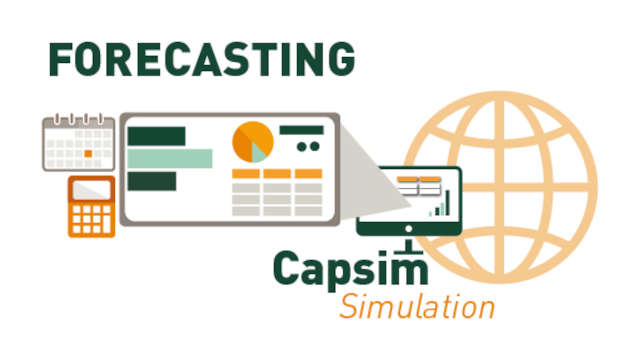Accurate forecasts can make or break a game
Hi, and welcome to the second part of my guide to Capsim. I am Dr. Larry Chasteen, and I am writing this blog to share the knowledge I’ve gained using the Capsim Foundation Challenge in my undergraduate and graduate strategic management courses. I consider the Capsim simulation a crucial piece for students to get a taste of the real world of corporate management. Among my students who have competed in this business simulation challenge, many have secured top winning spots in worldwide tournaments.
If you are currently playing Capsim and you read my first blog (if you haven’t yet, I recommend you begin with Capsim: How to Win), you probably have started making decisions in your game. I know that entering the simulation can feel like trying to drink water out of a firehose, but the best advice I can give you is to be patient and check in with your team members. It will all get easier as you go. The worse thing to do at this point is to quit since you have already spent time and dedication setting up your business and making the first decisions. Keep at it; you can do it!
Let’s talk about the real crux of the game — forecasting.

What is forecasting?
To forecast is to predict future sales using previous data. Forecasting accurately in Capsim allows players to make the best business decisions possible and to make large profits without any emergency loans.
Approaches for forecasting in Capsim
You cannot make an accurate forecast without accurate data. You make the estimate during the second year of operations by looking at what you did in the year before. The best information you can obtain comes from your business’ performance during that first year of operations. Because the market usually grows about 10% on low-tech products and about 20% on high-tech products, you may assume that your business will grow by about 15%. So, look at what you sold last year and add 15% to it as a starting point. As other teams add products to their inventory, forecasting becomes more challenging, and you will have to change your strategy.
Decide on a forecasting strategy. There are two approaches that are described in the next section on Methods to forecast in Capsim.
Market share approach (actual vs. potential)
Market share × Total industry unit demand × (1 + next year’s growth rate)
Customer-survey approach (future information)
Product’s December customer survey ÷ total customer survey
Two forecasts are also needed:
- Best case forecast – Plan for the best-case scenario (mitigate the risk of stock out)
- Worst case forecast – Plan for the worst-case scenario (mitigate the risk of emergency loans)
Look at the forecasting chapter in the team member guide for more information on the two forecasting approaches and also the best case/worse case forecasts. There is also a forecasting video from BYU-Hawaii professor Jeff Caneen that covers all of these techniques in more detail.
Methods to forecast in Capsim
Forecasting in the opening one or two rounds is manageable because most teams will have one or two products and the market share approach will work OK. But by the fourth round, some teams might have four or five products. It is safe to assume that the new products will get some of the market share. At this point, you cannot expect each of your products to grow at a 15% rate anymore. You have to look at all the products and how they are doing in the market. At this point the customer-survey approach works better.
Start a spreadsheet to keep track of customer ratings each year; it will tell you how much customers like your products in comparison to the products of other teams. By carefully looking at the data you gather, you will see if you are getting a significant percentage of the market share. You will also know what the market growth is going to be. Each product will get a share of the market, so by looking at the end of the year survey, you can see if your products will get a significant percentage. You can now adjust production and stock accordingly. Refer back to the forecasting video mentioned above to see examples.
If you predict a shortage of your product, know that it is always better not to run out of stock, so that you do not miss on selling opportunities. If you don’t have any products to sell, other teams will still be able to sell their products. They will then take a significant percentage of the market share — even if their products are sub-par — because they have inventory, and you do not. This situation will definitely hurt you because you are competing against the other teams.
So, you don’t want to run out of stock, but at the same time, you don’t want to have too much inventory. Excess product will lead to a cash problem that will eventually force you to get an emergency loan. To prevent any cash-flow hurdles, plan to borrow a little more money than you think you will need. Do it from the beginning so that you will have a cash cushion of 8 million to 10 million dollars.
I hope this guide helps you use forecasting as a tool to advance successfully in the Capsim simulation. I encourage you to learn as much as you can from the overall experience of playing this game. The challenges of this simulation much resemble the scenarios you will encounter out there in the business world.





